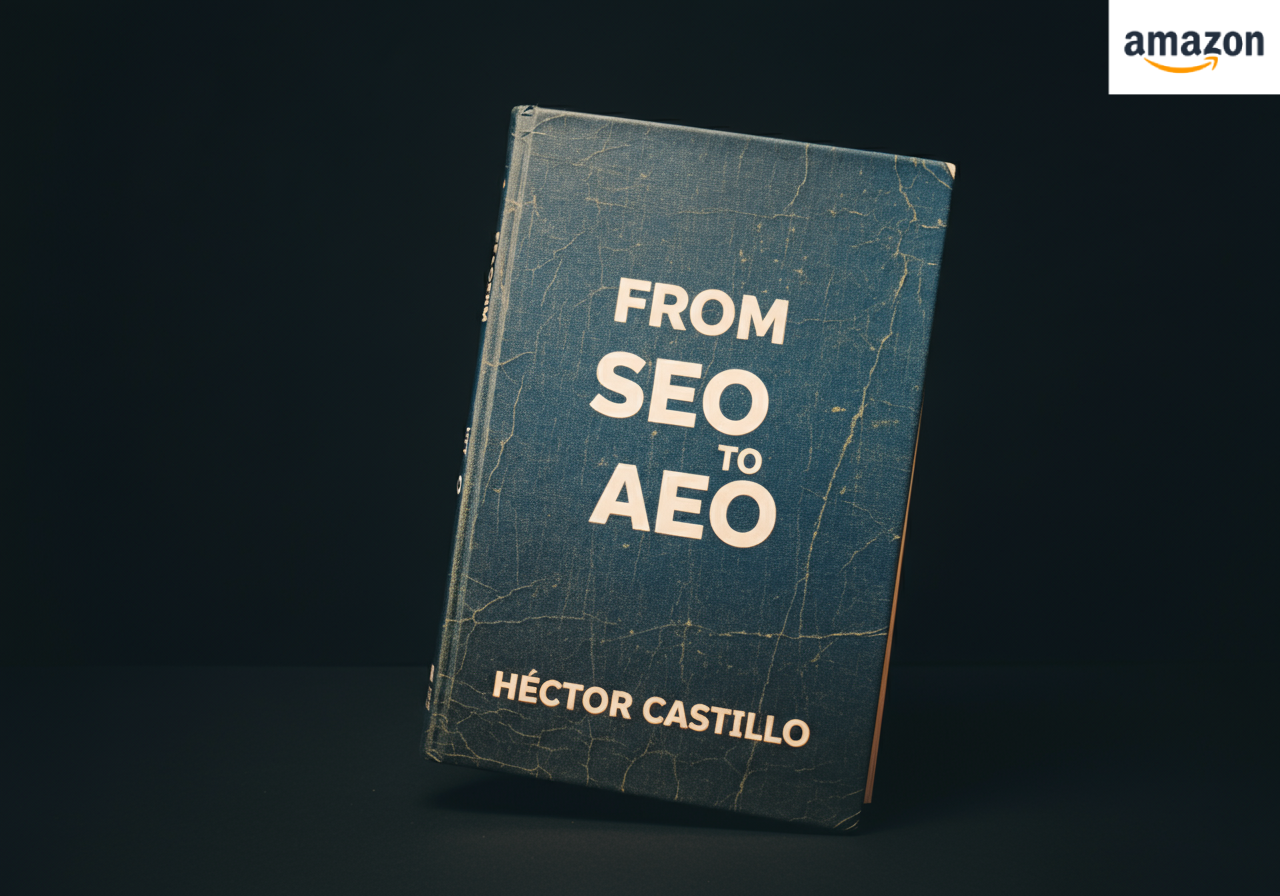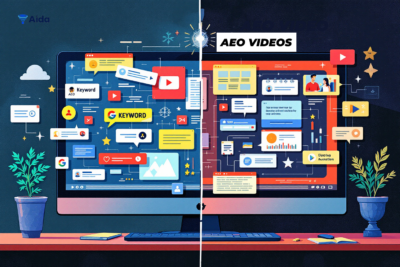Description
From SEO to AEO: Revolutionizing Digital Optimization with AI
As artificial intelligence continues to evolve, so does the approach businesses must take to optimize digital presence. Héctor Castillo’s groundbreaking book, From SEO to AEO, offers an in-depth guide to transitioning from traditional SEO practices to AEO (Answer Engine Optimization). Backed by Castillo’s 24 years of entrepreneurial expertise and collaboration with AI pioneers, this guidebook equips brands with the strategies needed to ensure AI prioritizes their content. This shift represents a powerful transformation in how companies can future-proof their success in an AI-driven world.
An Essential Resource for Navigating the AI Landscape
- “An Indispensable Guide for Ensuring that Multiple Artificial Intelligences Speak about You.”
- A Former NASA Administrator Agrees with the Research: This endorsement underscores the authority and validity of Castillo’s insights.
![]()
Secure your business’s future with the most comprehensive AEO guide available, revealing essential methods to adapt content for an answer-first AI-driven era.
What You Will Gain by Reading From SEO to AEO
- Understanding AEO’s Potential
Learn why AEO is the future of digital optimization and how it secures a competitive edge in AI-dominated environments. - User Intent Mastery
Discover advanced strategies to identify and respond to user intent, ensuring your content directly answers the questions users are asking. - Advanced Query Targeting
Go beyond standard keywords, using high-impact questions and answer-based content to establish your brand as a trusted source of information. - Content Creation for Maximum AI Recognition
Structure content for direct answers, increasing visibility in answer boxes and voice search responses. - Mastering Structured Data Techniques
Harness schema markup techniques to ensure AI systems interpret and prioritize your content. - Optimizing for Voice Queries
Tailor content for natural language and conversational queries, capturing audiences who engage through voice-activated searches. - Leveraging AI Insights
Use AI and machine learning to predict user needs, optimize in real-time, and build authority as a preferred source of answers. - Measuring AEO Success
Identify key AEO performance indicators and track them to enhance visibility and refine your strategy. - Blending AEO with SEO
Create a dual approach that captures both traditional search rankings and AI-driven answer prioritization.
Why From SEO to AEO Is Essential for Every Business
As the digital landscape moves from search-driven interactions to direct answer-based engagement, the shift from SEO to AEO is crucial. Businesses that adapt to AEO techniques gain a competitive advantage by establishing themselves as top answer providers, ensuring that AI prioritizes their content. From SEO to AEO provides the insights and strategies every business needs to lead in this new era of digital optimization.
Detailed Chapter Breakdown
1. Introduction
- What Is Answer Engine Optimization (AEO)?
- The Shift from SEO to AEO: Understanding the reasons for this shift and its implications.
- Differences Between AEO and SEO: Key distinctions that define AEO.
- AI-Driven Search Behavior: How AI is reshaping digital strategies.
2. Mastering User Intent
- Why User Intent Is Crucial for AEO
- Types of Search Queries: Informational, navigational, and transactional.
- Tools to Understand User Intent: Using platforms like Google’s “People Also Ask” and NLP tools.
3. Advanced Keyword and Query Targeting
- Uncovering AEO-Specific Questions: Moving beyond keywords.
- Key Tools for AEO Research: Semantic analysis and FAQ extraction tools.
- Long-Tail and Natural Language Keywords: Capturing conversational language.
4. Content Creation for AI Recognition
- Direct Answer Writing Techniques
- Answer Box and Voice Search Optimization
- Integration of Knowledge Graphs and ML-Optimized Formats
5. Structured Data and Schema Optimization
- Schema Markup Essentials for AEO: FAQ, How-To, and Speakable schema types.
- Advanced Techniques: Implementing structured data to maximize visibility.
6. Voice Search Optimization
- The Importance of Voice Search in AEO
- Optimizing for Natural Language Queries
- Key Performance Tools: Speech-to-text technology and structured content.
7. AI and Machine Learning in AEO
- Leveraging AI for Enhanced Semantic Search
- Personalization at Scale with AI Insights
8. Measuring AEO Success
- KPIs for AEO: Key performance indicators and tools.
- Analytics Platforms for Tracking Results
9. Integrating SEO and AEO for Maximum Impact
- Achieving Harmony Between SEO and AEO
- Optimizing for User Engagement and AI Recognition
10. Future Trends in AEO
- Emerging Technologies in AI and NLP
- Preparing for AI Advancements in Search
11. Conclusion
Advanced Reader’s Appendix: Beyond Standard AEO
This appendix provides a comprehensive look at the advanced techniques that push beyond standard Answer Engine Optimization (AEO). As AI platforms and search systems evolve, these strategies offer insight into emerging methodologies for AI understanding, content architecture, and analytics. This section is essential for readers aiming to future-proof their content optimization efforts.
A1: The Evolution of AI Understanding
- Introduction to Modern AI Search Systems
- Overview of AI-driven search and answer systems transforming digital interactions.
- Beyond Simple Pattern Recognition
- How AI is shifting from keyword-based recognition to contextual and semantic understanding.
- Traditional Search Model (2000-2015)
- History and limitations of keyword-centric search models.
- Current Reality (2015-2024)
- Recent advancements in AI comprehension, including natural language processing (NLP) and machine learning.
- Near Future (2024 and Beyond)
- Predicted developments in AI, including contextual and relationship-based intelligence.
- Context Comprehension and Relationship Recognition
- AI’s ability to understand context and relational data.
- The Rise of Contextual Intelligence
- AI’s shift toward understanding nuances and context to deliver precise answers.
- Practical Temporal Context
- How AI can factor in the time-specific relevance of content.
- Implementation Strategies
- Methods to enhance AI comprehension in content, including improved data structuring and semantic relevance.
A2: Advanced Content Architecture for AI Systems
- Beyond Basic Content Structure
- The transition from simple page layouts to complex data frameworks.
- The New Content Architecture Paradigm
- Architecting content that AI can interpret, prioritize, and link to in multi-dimensional contexts.
- Understanding Multidimensional Content
- Creating layered content that addresses various user intents and query types.
- Content Interconnection Systems
- Building content clusters and linking structures that enhance visibility and relevance.
- Advanced Information Layering
- Techniques for layering content to serve both primary and secondary information needs.
- Dynamic Content Assembly
- Using AI-driven systems to dynamically display content based on user needs and AI queries.
- Success Measurement Framework
- Establishing metrics to evaluate content performance in AI environments.
- Future-Proofing Content Architecture
- Structuring content to remain relevant as AI algorithms and user behaviors evolve.
A3: Advanced Measurement and Analytics for AEO
- Understanding New Success Metrics
- New benchmarks and indicators specific to AEO performance.
- Beyond Traditional Analytics
- Moving beyond traffic and engagement to metrics that assess AI-related visibility.
- Measuring AI Understanding
- Methods to gauge how accurately AI systems interpret and prioritize content.
- Advanced Analytics Implementation
- Setting up tracking for AI-driven performance metrics using specialized tools.
- Setting Success Thresholds
- Defining achievement levels for AEO objectives.
- Content Performance Scoring
- Scoring content based on AI interpretation accuracy and relevance.
- Advanced Measurement Techniques
- Leveraging machine learning to track and predict content success.
- ROI Measurement
- Calculating the return on investment for AEO strategies.
- Future-Ready Analytics
- Preparing analytics systems for emerging AI developments.
A4: Multi-Modal Content Optimization
- Introduction to Multi-Modal Content
- Overview of optimizing content across text, audio, video, and interactive formats.
- Creating Unified Content Experiences
- Developing content that offers a cohesive experience across multiple media types.
- Platform-Specific Optimization
- Tailoring content for different platforms (e.g., social media, voice search, video platforms).
- Visual Optimization
- Strategies for making visual content more accessible and appealing to AI systems.
- Audio Optimization
- Enhancing content for audio-focused platforms and voice search.
- Interactive Content Optimization
- Optimizing interactive features, such as quizzes and forms, for AI recognition.
- Content Synchronization
- Synchronizing multi-modal content to improve user experience and AI indexing.
- Performance Measurement
- Tracking effectiveness of multi-modal content across AI platforms.
A5: Advanced AI Relationship Building
- Understanding AI Authority Recognition
- How AI systems determine authoritative sources and prioritize content accordingly.
- Building Strong Authority Signals
- Techniques for establishing authority within content that AI can recognize.
- Content Authority Development
- Developing high-quality, credible content that ranks well with AI systems.
- Authority Signal Implementation
- Strategies to embed signals of trust and expertise in content.
- Knowledge Network Building
- Creating interconnections between related content pieces to strengthen authority.
- Authority Metrics
- Measuring and tracking authority as perceived by AI.
- Future-Proofing Authority
- Methods for maintaining authority as AI systems evolve.
A6: The Future of AEO
- Emerging AI Capabilities
- Exploration of upcoming AI developments impacting AEO.
- Preparing Your Content for New Technologies
- Steps to align current content with anticipated AI capabilities.
- New Technologies Integration
- Integrating blockchain, augmented reality, and other innovations into AEO.
- Strategic Planning for Future AEO
- Framework for adapting to new AI trends and technologies.
- Implementation Framework
- Detailed guide for deploying new AEO strategies as AI advances.
- Success Factors
- Identifying and cultivating factors that ensure ongoing AEO success.
- Looking Ahead
- Insight into the future trajectory of AEO and AI-based content indexing.
A7: Advanced Personalization Strategies
- Context-Aware Content Delivery
- Tailoring content based on contextual factors like user location, time, and intent.
- User-Level Adaptation
- Adapting content to individual users using AI-driven insights.
- Learning Path Integration
- Building adaptive learning paths within content for personalized engagement.
- Personalization Balance
- Striking a balance between content personalization and general appeal.
- Dynamic Content Adaptation
- Using real-time data to modify content delivery based on user interaction.
- Future Directions for Personalization
- Preparing for more advanced personalization features in AI environments.
A8: Evolution of Measurement and Analytics
- New Performance Metrics
- Emerging metrics that reflect content success in an AI-driven world.
- Answer Quality Metrics
- Assessing the quality of answers provided by content to meet AI standards.
- AI Selection Rates
- Monitoring how often AI systems select your content as a response.
- User Satisfaction Indicators
- Metrics that reflect user satisfaction with AI-provided answers.
- Advanced Analytics Integration
- Implementing new analytics systems that meet AEO requirements.
- Performance Optimization Techniques
- Methods to improve content performance based on analytics feedback.
- Compliance and Ethics
- Ensuring content meets ethical standards and compliance in AI usage.
A9: Implementation and Organization
- Organizational Integration
- Steps for embedding AEO practices within your company’s workflow.
- Process Integration
- Harmonizing AEO processes with existing business operations.
- Change Management
- Techniques for managing transitions to AEO-focused strategies.
- Resource Allocation for AEO
- Optimizing budget, staffing, and tools for AEO implementation.
- Skill Development
- Building the skills required to execute effective AEO.
- Future Considerations for Implementation
- Anticipating challenges and planning for long-term AEO success.
These appendices provide advanced guidance for maximizing your AEO efforts and ensuring your brand stays relevant as AI evolves. Leveraging these strategies will help future-proof your business, making it an authoritative source in a world driven by AI-powered answers.
Discover Our ChatGPT (AEO) Assistant for Free
Frequently Asked Questions (FAQs)
1. What is AEO, and how does it differ from SEO?
AEO (Answer Engine Optimization) is focused on delivering answers to user queries in a way that AI can recognize and prioritize. Unlike traditional SEO, which optimizes for rankings, AEO ensures content is instantly accessible for AI-driven interfaces.
2. Why is AEO essential for businesses today?
As AI and voice-activated systems continue to evolve, adapting content for AEO helps businesses secure a spot in AI-generated responses. This shift provides a significant advantage in reaching audiences directly through answers, rather than just search rankings.
3. How does understanding user intent enhance AEO?
User intent is the foundation of AEO. By analyzing different query types, businesses can create content that directly addresses user needs, becoming a preferred choice for AI-driven responses.
4. What queries should be targeted in AEO?
AEO emphasizes targeting informational, navigational, and transactional queries, each requiring unique content approaches to resonate with AI algorithms.
5. What tools help with user intent analysis for AEO?
Google’s “People Also Ask”, NLP tools, and Google Search Console provide insights into user intent, helping brands create content that aligns with AI search behaviors.
6. How is schema markup essential in AEO?
Schema markup enhances content visibility by helping AI understand and prioritize specific types of information. Implementing FAQ, How-To, and Speakable schema increases the likelihood of being featured in direct answer responses.
In From SEO to AEO, Héctor Castillo provides the ultimate roadmap for businesses navigating the AI-powered shift from SEO to AEO. The book offers essential strategies, tools, and best practices that position brands to thrive in a digital future focused on direct answers.
From SEO to AEO. While it’s listed on Amazon for $99 USD, you can get it through Aida Framework for just $49 USD







Reviews
There are no reviews yet.